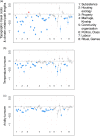Geography is not destiny: A quantitative test of Diamond's axis of orientation hypothesis
- PMID: 38274321
- PMCID: PMC10808877
- DOI: 10.1017/ehs.2023.34
Geography is not destiny: A quantitative test of Diamond's axis of orientation hypothesis
Abstract
Jared Diamond suggested that the unique East-West orientation of Eurasia facilitated the spread of cultural innovations and gave it substantial political, technological and military advantages over other continental regions. This controversial hypothesis assumes that innovations can spread more easily across similar habitats, and that environments tend to be more homogeneous at similar latitudes. The resulting prediction is that Eurasia is home to environmentally homogenous corridors that enable fast cultural transmission. Despite indirect evidence supporting Diamond's influential hypothesis, quantitative tests of its underlying assumptions are currently lacking. Here we address this critical gap by leveraging ecological, cultural and linguistic datasets at a global scale. Our analyses show that although societies that share similar ecologies are more likely to share cultural traits, the Eurasian continent is not significantly more ecologically homogeneous than other continental regions. Our findings highlight the perils of single factor explanations and remind us that even the most compelling ideas must be thoroughly tested to gain a solid understanding of the complex history of our species.
Keywords: Axis of orientation hypothesis; cultural biogeography; cultural evolution.
© The Author(s) 2024.
Conflict of interest statement
The authors declare none.
Figures





Similar articles
-
Geographic axes and the persistence of cultural diversity.Proc Natl Acad Sci U S A. 2012 Jun 26;109(26):10263-8. doi: 10.1073/pnas.1205338109. Epub 2012 Jun 11. Proc Natl Acad Sci U S A. 2012. PMID: 22689972 Free PMC article.
-
A test of the influence of continental axes of orientation on patterns of human gene flow.Am J Phys Anthropol. 2011 Dec;146(4):515-29. doi: 10.1002/ajpa.21533. Epub 2011 Sep 13. Am J Phys Anthropol. 2011. PMID: 21913175 Free PMC article.
-
Cultural transmission and ecological opportunity jointly shaped global patterns of reliance on agriculture.Evol Hum Sci. 2020 Oct 26;2:e53. doi: 10.1017/ehs.2020.55. eCollection 2020. Evol Hum Sci. 2020. PMID: 37588375 Free PMC article.
-
The environmental context of human evolutionary history in Eurasia and Africa.J Anat. 2008 Apr;212(4):377-93. doi: 10.1111/j.1469-7580.2008.00872.x. J Anat. 2008. PMID: 18380862 Free PMC article. Review.
-
Perimetry, tonometry and epidemiology: the fate of glaucoma management.Acta Ophthalmol. 2011 Jun;89(4):309-15. doi: 10.1111/j.1755-3768.2011.02169.x. Acta Ophthalmol. 2011. PMID: 21615711 Review.
References
-
- Alberti, G. (2019). movecost: An R package for calculating accumulated slope-dependent anisotropic cost-surfaces and least-cost paths. SoftwareX. 10, 100331.
-
- Ammerman, A. J., & Cavalli-Sforza, L. L. (1971). Measuring the rate of spread of early farming in Europe. Man, 6(4), 674–688.
-
- Bates, D., Mächler, M., Bolker, B., & Walker, S. (2015). Fitting linear mixed-effects models using lme4. Journal of Statistical Software, 67, 1–48.
-
- Benjamini, Y., & Yekutieli, D. (2001). The control of the false discovery rate in multiple testing under dependency. The Annals of Statistics, 29, 1165–1188.
-
- Blaut, J. M. (1999). Environmentalism and eurocentrism. Geographical Review, 89(3), 391–408.
LinkOut - more resources
Full Text Sources
Miscellaneous
